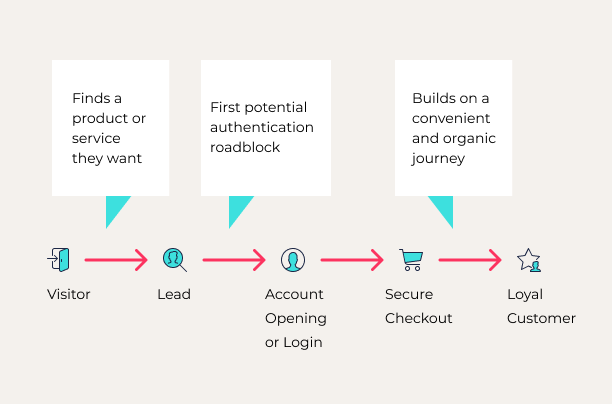How to Improve the Ecommerce Customer Experience with Passwordless Authentication
Let’s face it: ecommerce isn’t a novelty anymore. It has become an essential part of daily life. According to a UN trade report, ecommerce sales soared to $26.7 trillion in 2020, up 4% from 2018. Another 2020 report from IBM suggests that the pandemic accelerated the shift to online retail by at least five years. However, as online retail has grown, so have customer expectations.
Today’s consumers expect an effortless experience from the moment they enter a webstore. Although they still care about privacy and security, customers are less willing to sacrifice a seamless experience for intangible improvements to safety. Now the emphasis is on making everything smooth and fast: smoother shopping, faster shipping and seamless logins, this is where passwordless ecomerce comes in.
But nothing stops an online shopper in their tracks like a forgotten password or account lockout. Authentication issues are among the worst obstacles a customer can face when shopping online, and ecommerce organizations must address them if they want to maintain a competitive edge.
In this article, we’ll discuss how online retailers can take advantage of passwordless authentication to earn loyal customers, reduce support overhead and drive deeper revenue. Truly passwordless authentication removes passwords from all parts of the login process, meaning it’s built from the ground up with passwordless authentication in mind. First, let’s talk about giving your customers the authentication experience they want — not the one they’re conditioned to put up with.
Improve customer loyalty and reduce cart abandonment

What makes a good shopping experience? For most shoppers, it’s convenience. If something can’t be found, ordered and delivered straight to their door with a minimum of fuss, consumers will take their business elsewhere. That sentiment applies across the entire customer experience. And, crucially, that includes authentication. Let’s take a look at a typical customer experience flow using the chart below:

As you can see in the flowchart, authentication is a crucial stepping stone to making a purchasing decision. It’s this step that can make or break an ecommerce shopping experience. If customers are put off by a difficult authentication process, they might become frustrated and give up. Worse still, they may take their business to a competitor who provides a more comfortable authentication experience. According to research from Mastercard, a third of customers will simply walk away if they get locked out of their account.
Whenever customers are forced to register a new account with a username and password, they’re obligated to add yet another entry to their ever-expanding virtual keyring. Considering that most online consumers frequent dozens of digital storefronts, it can be quite a hassle to remember all these different credentials. Since it’s so easy to get confused or forget passwords, customers are often confronted with an account lockout and are forced to reset their logins. A Transmit Security survey discovered that 64.5% of customers will leave a site if they’re forced to register a new username and password.
Upgrading to a customer-centric, natively passwordless authentication service removes the burden of complex registration requirements and hard-to-remember passwords. With built-in biometric device authentication, customers can register using their fingerprint or facial recognition. Subsequent logins are simple: they receive a prompt for biometrics on their device, they scan their face or finger and gain access. Passwordless authentication turns a process that used to take several stressful minutes into a one-touch operation.
When authentication is smooth and organic, customers are free to enjoy an uninterrupted shopping experience. They’re significantly more likely to make a purchase, return to the webstore and recommend it to others. At the same time, it prevents losing an angry customer because they were locked out of their account. That lost customer will undoubtedly express their frustration to others, which is harmful to your store’s reputation.
Reduce dependencies and support costs with passwordless ecommerce
For many online retailers, password resets and the associated infrastructure (i.e., call centers and support ticketing) can present an uncomfortable tug on tight purse strings. Some retailers already know exactly how much each password reset costs them down to dollars and cents. The net costs per year can be overwhelming, with the largest retailers spending millions of dollars just to restore accounts and reset passwords.
Passwordless authentication eliminates the need for this support infrastructure. Even in extreme edge cases, natively passwordless services won’t incur the same financial penalties as typical password-based implementations. With identity portability, or the ability to link multiple devices with biometric readers to the same account, customers can easily transfer trust from one device to another.
With natively passwordless authentication, customers will never have to rely on frustrating reset processes to reobtain access to their accounts. And, even if a customer needs to resort to contacting a call center, they can still authenticate over the phone. With multichannel support, customers can authenticate on any app, device or channel of their choosing.
Drive deeper revenue by smoothing out the customer journey

With password or knowledge-based authentication, customers are obliged to generate new user IDs and difficult-to-crack passwords with every storefront that they visit. It’s such a roadblock that retailers forfeit potential customers with each forced registration page. In our recent report on the business impact of passwords, we discovered that 64.5% of consumers will abandon a website altogether if they’re asked to create a username and password.
Even long after registration, many customers rely heavily on browser-based cookies to remember their credentials for them. This is especially true for infrequent customers who only shop occasionally — unfortunately, the cookies that store their logins will eventually expire or be wiped. They must inevitably reset their account’s password, and this creates an enormous obstacle to purchasing decisions. These customers would happily leave the site rather than recover their accounts. More than 90% of users we surveyed prefer to beat a hasty exit over resetting their logins.
Going passwordless with a biometric-powered authentication service puts the reins back into the customer’s hands. Instead of forcing shoppers to ask “How much do I really want this product?” when faced with a registration page, they’re simply directed to a handful of easy authentication steps that organically drive them to checkout.
Similarly, eliminating the obligation to remember a password or store it as a browser cookie means users can simply scan their fingerprints and get back to shopping. This simple process helps conversion rates stay high and lowers the drop-off rate.
The next customer experience innovation in passwordless ecommerce lies with authentication
Transmit Security reduces the friction between online shoppers and their next satisfying purchase. We achieve this by eliminating passwords from every part of the authentication process, which means no user IDs, no passwords and no resets. We call this natively passwordless authentication. Instead of registering with a set of login credentials, customers can link biometric data, like a fingerprint or face scan, to their account. Whenever they want to log in, they receive a prompt on that device and gain access when it’s complete.
Transmit Security isn’t a simple authenticator, however. It provides an entire cybersecurity ecosystem to support and secure your customers throughout their ecommerce journey. Ready to learn more about how to make passwords obsolete? Find out how a global banking giant took 200 million customers passwordless in this case study.



